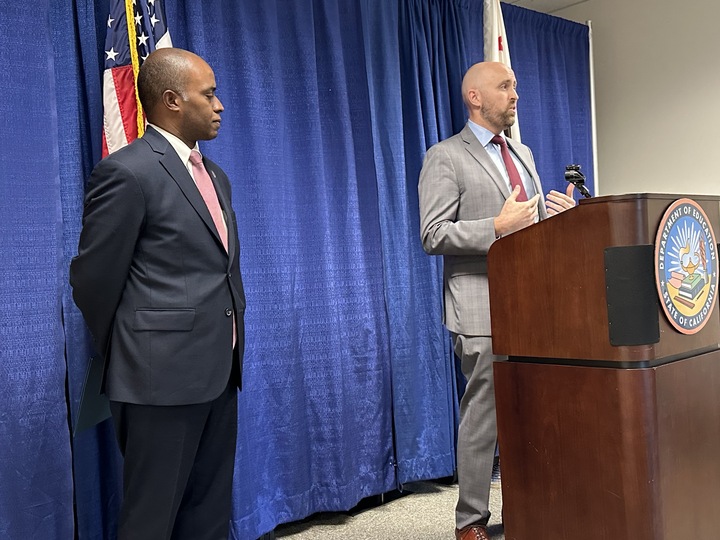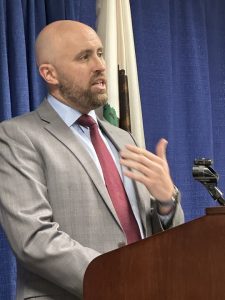On July 30, CSBA joined State Superintendent of Public Instruction Tony Thurmond, school system leaders and University of California researchers at the California Department of Education’s headquarters in Sacramento to help launch a statewide initiative that aims to create millions of housing units on land owned by local educational agencies.
The potential of this initiative was established in a report produced by CSBA in collaboration with the Terner Center for Housing Innovation at UC Berkeley, and CSBA’s education workforce housing partners, UCLA cityLAB and UC Berkeley Center for Cities + Schools, who provided the research cited in the July 30 press conference.
The report, Education Workforce Housing in California: Developing the 21st Century Campus, made possible by support from the Chan Zuckerberg Initiative, found that LEAs across the Golden State have approximately 75,000 acres of undeveloped land. According to one estimate, that acreage could be converted into as many as 2.3 million housing units, a significant step toward closing mitigating housing affordability issues, particularly for teachers and school employees.
The high cost of housing, driven in part by a shortage of dwellings, is often an issue for California residents — especially those in public service positions like teachers and school personnel. Further, a shortage of teachers is burdening the field. Education workforce housing (EWH) has the ability to address both of these challenges by offering employees affordable places to live in the communities they work in, which is a significant benefit for recruitment and retention.
During the press conference, CSBA Senior Director of Executive Office Operations and Strategic Initiatives Andrew Keller, who oversees the association’s workforce housing efforts, explained that CSBA has been exploring the use of surplus school property for housing since before the pandemic. The directive came from CSBA CEO & Executive Director Vernon M. Billy, who was determined to change how state policymakers and school officials view excess land and its possible functions.
Some LEAs have considered selling surplus property for short-term financial gains, but Billy has long advocated for preserving assets so they can benefit communities for years to come.
“That is the idea behind this approach, it’s keeping these assets in the community and finding ways that they can support the long-term financial health of these districts and county offices, and ultimately benefit the students they serve by having those teachers stay in the community,” Keller said.
With support from the Chan Zuckerberg Initiative and in partnership with the UCLA cityLAB and UC Berkeley Center for Cities + Schools, CSBA produced the Education Workforce Housing in California report and a companion handbook.
Every county in the state has LEA-owned land that may be suited for workforce housing projects, according to the report. The resource outlines development timelines and offers practical recommendations on navigating the process, designing housing to meet local needs and securing community buy-in.
State support
To develop land, LEAs can use local bonds, state tax credits or certificates of participation that are already available, according to Thurmond. Beyond creating educator housing, he said the state must “change the laws to allow local bond funds to be used if a school district wants to build housing for educators and for multi-family [units] for their students and families, many of whom are also priced out of local markets.”
Thurmond added that he’d like to find state incentives for LEAs to help them as they pass local bonds to build housing.
The State Superintendent is convening a panel of housing experts, including CSBA, to present at a Housing Summit on Aug. 14, where he hopes to identify policy recommendations that can support housing development projects in the state.
Local examples
Jefferson Union High School District board member Andy Lie detailed his district’s process to build 122 units of workforce housing. Open since May 2022, they are fully occupied with a waitlist. The units house 25 percent of the district’s staff, a mix of certificated and classified employees.
While the cost of housing in the Bay Area-based LEA was once a major issue that contributed to high turnover, “the past two years, on the first day of school, we have started the year with zero vacancies districtwide, which is just remarkable and unheard of in public education everywhere,” Lie said. “It’s been a remarkable project. The staff morale is up, but most importantly, we can’t give our best to our students if our educators are struggling with housing insecurity.”
Lie added that the units rent for 50 percent below market rate. And with higher retention rates, the curriculum and quality of education students receive is enriched.
In San Diego USD, plans are underway to house 10 percent of its workforce in the next decade, according to trustee Richard Barrera, who also serves as the senior policy advisor to the State Superintendent. It can be difficult for communities to grasp the idea of LEA’s building housing, he continued, although partnering with local unions, employees, neighborhood groups and developers and builders helps boost understanding and buy-in.
“It’s such a clear need that districts face … but this is new ground for school districts to jump in,” Barrera said. “When California decides we’re going to bring everybody together to come up with new solutions to fix old problems, we know we can succeed.”
Resources
CSBA’s Education Housing 101 Workshop Series is accepting applications for its next cohort from Sept. 3-18. The workshop series, which starts in January 2025, provides the tools and knowledge necessary to create a roadmap for affordable and inclusive staff housing options. Cohort members will learn from experts and practitioners including architects and researchers on EWH planning topics.
Watch the webinar “How to apply to CSBA’s 2025 workshop series on Education Workforce Housing” or view the slides for tips on how LEAs can make their applications stand out.
A plethora of EWH resources including the pivotal report and handbook, along with examples of projects and case studies from California, training materials and templates, research, media coverage and more are available at csba.org/workforcehousing.
At the press conference, Sara Hinkley, California program manager at the UC Berkeley Center for Cities + Schools, spoke about some of the tools, including interactive maps where LEAs can look up potentially developable land and data on educator turnover as well as housing affordability and teacher pay.
Manos Proussaloglou, UCLA cityLAB assistant director, noted that to scale current efforts, actions such as pursuing new legislation that builds on Assembly Bill 2295, raising funds for predevelopment work and engaging more housing experts needs to occur.
Other speakers at the press conference included Sen. Josh Becker (D-Menlo Park); Los Angeles USD Superintendent Alberto Carvalho; and Tristan Brown, California Federation of Teachers legislative director. View a recording of the press conference.






